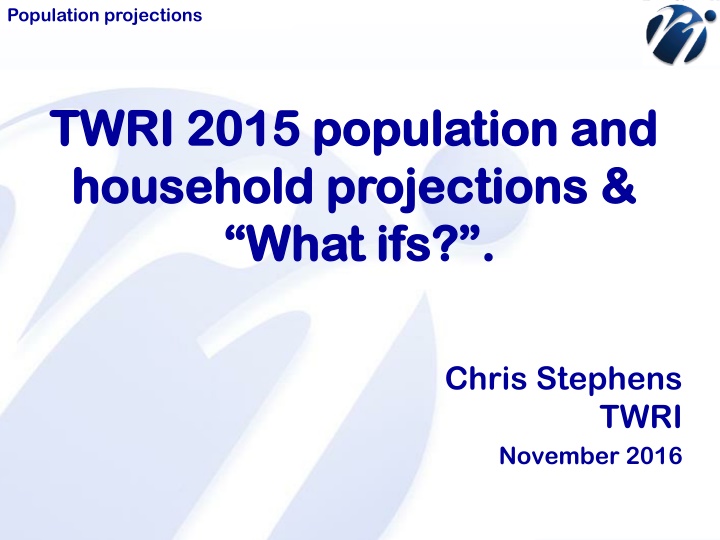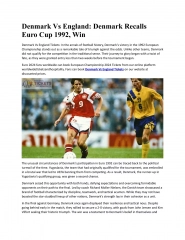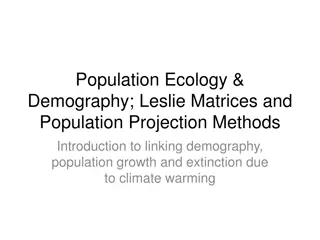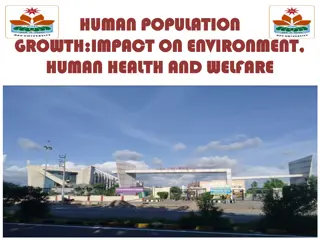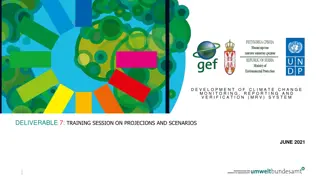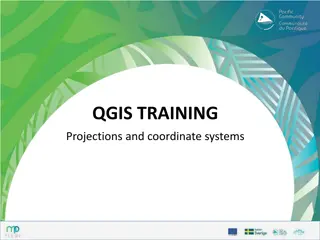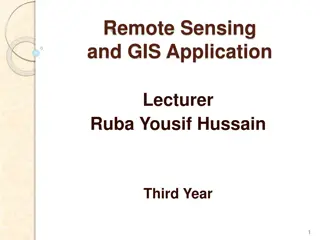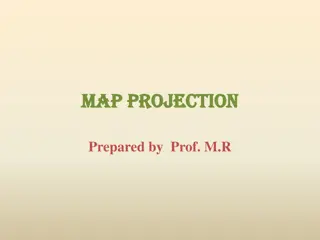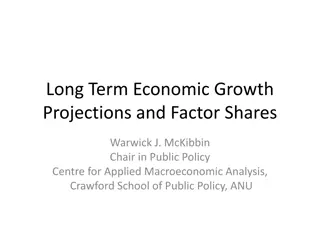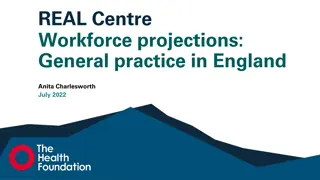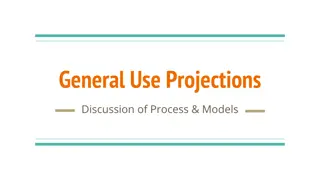England Population Projections and Methodologies
England is projected to experience significant population growth, with every 2% increase representing a city the size of Birmingham. The projections analyze factors such as birth rates, mortality rates, and various scenarios impacting population trends. The methodologies include cohort survival methods and scenario modeling for different population scenarios.
Download Presentation

Please find below an Image/Link to download the presentation.
The content on the website is provided AS IS for your information and personal use only. It may not be sold, licensed, or shared on other websites without obtaining consent from the author.If you encounter any issues during the download, it is possible that the publisher has removed the file from their server.
You are allowed to download the files provided on this website for personal or commercial use, subject to the condition that they are used lawfully. All files are the property of their respective owners.
The content on the website is provided AS IS for your information and personal use only. It may not be sold, licensed, or shared on other websites without obtaining consent from the author.
E N D
Presentation Transcript
Population projections Area AreaProfiler Profiler2 2 TWRI 2015 population and TWRI 2015 population and household projections & household projections & What ifs? . What ifs? . Education Chris Stephens TWRI November 2016
Population projections Area AreaProfiler Profiler2 2 General Comments General Comments England is almost certain to see significant population increase. For every 1% increase this represents a population growth of around 550,000. For every 2% increase this represents a new city the size of Birmingham.
Population projections Area AreaProfiler Profiler2 2 Some Definitions Some Definitions 1) Usually Resident Population. 2) Short-term Migrants. 3) A Population Estimate. 4) A Population Projection. 5) What ifs?
Population projections Area AreaProfiler Profiler2 2 Method used (1) Method used (1) We use the Cohort survival method. However, unlike ONS which, in their projections, constrain the sum of the districts to the England total, TWRI generally starts with a local authority, produce the projection and aggregate up. However, in this presentation, for England and London, we will use the general method, rather than aggregating districts. There is no constraint on any figure.
Population projections Area AreaProfiler Profiler2 2 Method used (2) Method used (2) We can produce a variety of scenarios, e.g. Natural Change only, Internal migration only, and a range of weightings. However, for this presentation, I want to concentrate on a simple basic model and consider some What ifs? for this model. Please note these are for demonstration purposes; we can produce different scenarios which the user may find more realistic.
Population projections Area AreaProfiler Profiler2 2 Fertility in England Fertility in England Birth rates: we use average of last 6 years. If, instead we used average of last 3 years, then, to 2040, there would be 2% less births, 370,000 (0.6%) fewer people, but just 17,000 (0.06%) less households by 2040. As it makes only a small difference we will use the average of the last 6 years.
Population projections Area AreaProfiler Profiler2 2 Mortality/Life expectancy in England Mortality/Life expectancy in England Death rates reduced by about 1.5% per year over the period 2001/02 to 2013/14. Did not continue for 2014/15 and 2015/16. Up substantially for 2014/15 (+8.5%). For the future, we assume that death rates, from mid-2015, will reduce by half the percentage decline 2001/02 to 2014/15. Full reduction would increase 960,000 (1.5%) & 670,000 (2.4%) h/holds. increase pop. by
Population projections Area AreaProfiler Profiler2 2 Chart showing Observed and Expected crude death rates per 1000 residents, for England 2001/02 to 2015/16. [See Note at the foot of the chart.] 10.0 Observed and Expected Death Rates per 1000 residents. 9.5 9.0 Observed Expected 8.5 8.0 -2002 -2003 -2004 -2005 -2006 -2007 -2008 Year ending June 30th. -2009 -2010 -2011 -2012 -2013 -2014 -2015 -2016 [N.B. This chart uses the results over the period 2001/02 to 2012/13 (i.e. 12 years) as the base period for the projection.]
Population projections Area AreaProfiler Profiler2 2 International Migration International Migration In the six years to mid-2015, just over 3m International migrants came to England for 1 year+. Similarly 1.7m left. As a result, avg. growth= 220,000 per year. But ONS assume that this will be 170,000, after 2020. This is at least questionable for a Principal projection. TWRI use the average over six years. However, because of a reduction improved improved life expectancy life expectancy, like ONS, this still leads to 63.57m 63.57m for 2040. reduction in
Population projections Area AreaProfiler Profiler2 2 Table 1: England Table 1: England - - Population Projections Population Projections Source and base year ONS TWRI 2012 2012 53.49 53.49 54.23 54.33 54.61 54.75 56.96 57.13 58.78 58.92 60.42 60.50 61.89 61.92 62.17 62.18 62.72 62.99 ONS 2008 52.95 53.71 54.09 56.43 58.33 60.07 61.64 61.94 62.53 62.83 ONS 2010 53.11 54.02 54.47 57.02 58.98 60.75 62.40 62.73 63.38 63.71 ONS 2014 TWRI 2014 TWRI 2015 Year 2012 2014 2015 2021 2026 2031 2036 2037 2039 2040 Mid-year England residential population in millions. 54.32 54.78 57.25 59.14 60.85 62.40 62.70 63.28 63.57 54.32 54.74 57.21 59.12 60.87 62.47 62.77 63.38 54.79 57.18 59.08 60.82 62.38 62.68 63.27 63.57
Population projections Area AreaProfiler Profiler2 2 What ifs? What ifs? We now look at the base and 3 other options for the TWRI 2015 projections. a) The base figures, b) Improved life expectancy, c) After mid-2019, no international migration, and d) After mid-2019, only 30% of international migration.
Population projections Area AreaProfiler Profiler2 2 Table 2: Pop. Proj.: ONS, TWRI & What ifs? Table 2: Pop. Proj.: ONS, TWRI & What ifs? England: Source, base year and What ifs? ONS 2014 (a) 54.32 54.78 54.79 57.25 57.18 59.14 59.08 60.85 60.82 62.40 62.38 63.57 63.57 Options: a) Base, b) Improved death rate, c) No international migration beyond 2019 and d) 30% international migration beyond 2019. Mid-year England residential population in millions. TWRI (b) 2015 (c) Year 2014 2015 2021 2026 2031 2036 2040 (d) 54.79 57.27 59.33 61.30 63.13 64.53 54.79 56.73 57.41 57.77 57.83 57.75 54.79 56.87 57.91 58.68 59.20 59.50
Population projections Area AreaProfiler Profiler2 2 Table 3: Pop. Proj.: ONS, TWRI & What ifs? Table 3: Pop. Proj.: ONS, TWRI & What ifs? London: Source, base year and What ifs? ONS 2014 (a) 8.54 8.70 8.67 9.41 9.42 9.89 10.03 10.33 10.62 10.74 11.20 10.98 11.54 11.65 Options: a) Base, b) Improved death rate, c) No international migration beyond 2019 and d) 30% international migration beyond 2019. Mid-year London residential population in millions. TWRI (b) 2015 (c) Year 2014 2015 2021 2026 2031 2036 2039 2040 (d) 8.67 9.43 10.06 10.68 11.30 11.67 11.79 8.67 9.22 9.32 9.33 9.30 9.26 9.24 8.67 9.28 9.53 9.72 9.87 9.94 9.96
Population projections Area AreaProfiler Profiler2 2 Table 4: Pop. Proj.: ONS, TWRI & What ifs? Table 4: Pop. Proj.: ONS, TWRI & What ifs? Gateshead: Source, base year and What ifs? ONS 2014 (a) 200.5 200.8 201.0 203.7 201.8 206.1 201.9 208.6 201.1 210.3 200.1 211.5 199.1 198.7 Options: a) Base, b) Improved death rate, c) No international migration beyond 2019 and d) 30% international migration beyond 2019. Mid-year Gateshead residential population in thousands. TWRI (b) 2015 (c) Year 2014 2015 2021 2026 2031 2036 2039 2040 (d) 201.0 202.2 202.7 202.5 201.5 200.2 199.8 201.0 201.7 201.3 200.0 198.5 197.2 196.7 201.0 201.7 201.5 200.3 199.0 197.8 197.3
Population projections Area AreaProfiler Profiler2 2 Projecting numbers of Households Projecting numbers of Households DCLG projections: What s their purpose? DCLG Table 414. Household Reference Person. The DCLG spreadsheet age groups are not divided by sex. 8 age groups: Under 25, 25-34, 35-44, 45-54, 55-64, 65-74, 75-84 and 85 & over.
Population projections Area AreaProfiler Profiler2 2 Table 5: H hold. proj. DCLG, TWRI & What ifs? Table 5: H hold. proj. DCLG, TWRI & What ifs? England: Source, base year and What ifs? DCLG 2014 (a) 22.75 22.98 22.99 24.37 24.25 25.45 25.30 26.50 26.25 27.46 27.18 28.00 27.69 27.85 Options: a) Base, b) Improved death rate, c) No international migration beyond 2019 and d) 30% international migration beyond 2019. Mid-year England households in millions. TWRI (b) 2015 (c) Year 2014 2015 2021 2026 2031 2036 2039 2040 (d) 22.99 24.31 25.47 26.58 27.69 28.32 28.52 22.99 24.13 24.81 25.32 25.73 25.90 25.94 22.99 24.17 24.96 25.60 26.16 26.43 26.52
Population projections Area AreaProfiler Profiler2 2 Table 6: H hold. proj. DCLG, TWRI & What ifs? Table 6: H hold. proj. DCLG, TWRI & What ifs? London: Source, base year and What ifs? DCLG 2014 (a) 3.45 3.52 3.52 3.89 3.90 4.18 4.24 4.44 4.59 4.70 4.95 4.84 5.18 5.25 Options: a) Base, b) Improved death rate, c) No international migration beyond 2019 and d) 30% international migration beyond 2019. Mid-year London households in millions. TWRI (b) 2015 (c) Year 2014 2015 2021 2026 2031 2036 2039 2040 (d) 3.52 3.90 4.26 4.63 5.03 5.27 5.36 3.52 3.84 4.02 4.17 4.31 4.38 4.40 3.52 3.86 4.08 4.29 4.50 4.62 4.65
Population projections Area AreaProfiler Profiler2 2 Table 7: H hold. proj. DCLG, TWRI & What ifs? Table 7: H hold. proj. DCLG, TWRI & What ifs? Gateshead: Source, base year and What ifs? DCLG 2014 (a) 89.9 90.2 90.2 93.0 91.4 95.1 92.4 97.0 92.7 99.0 93.3 100.0 93.3 93.3 Options: a) Base, b) Improved death rate, c) No international migration beyond 2019 and d) 30% international migration beyond 2019. Mid-year Gateshead households in thousands. TWRI (b) 2015 (c) Year 2014 2015 2021 2026 2031 2036 2039 2040 (d) 90.2 91.7 93.0 93.8 94.8 95.0 95.0 90.2 91.5 92.5 92.8 93.3 93.3 93.3 90.2 91.5 92.5 92.8 93.3 93.3 93.3
Population projections Area AreaProfiler Profiler2 2 Conclusions Conclusions The future is always unpredictable but this uncertainty is only enhanced by the current political issues. However, we do have a computer based model which can be used to accommodate many variants for fertility, life expectancy and migration patterns. Generally, we project the population & number of households in England and London to increase. The picture for Gateshead is more mixed, but all models project an increase in the number of households.
Population projections Area AreaProfiler Profiler2 2 TWRI Web Site: www.twri.org.uk www.twri.org.uk TWRI E-mail: kadhem.jallab@twri.org.uk kadhem.jallab@twri.org.uk twri@twri.org.uk twri@twri.org.uk
